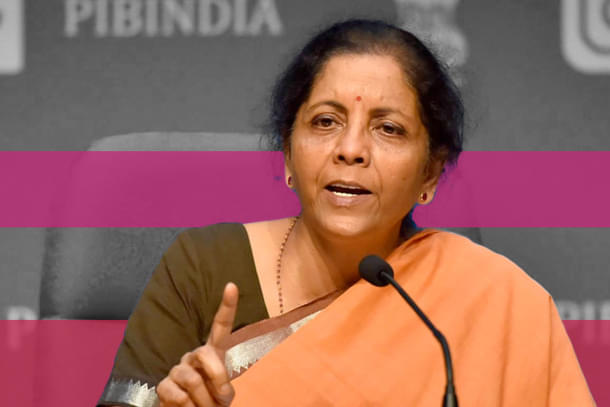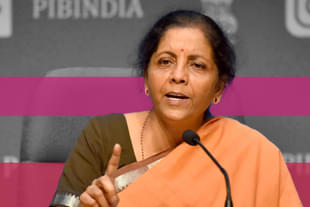Economy
In Incentives For First Time Hirings, Government’s Message To The Corporates- We Have Done Our Part, Now Create More Jobs
Krishna Dange
Jul 24, 2024, 05:57 PM | Updated 06:02 PM IST
Save & read from anywhere!
Bookmark stories for easy access on any device or the Swarajya app.


Union Government’s Budget for the financial year 2024-25 (FY25) presented on July 23, 2024 took cognizance of the persistent high unemployment levels in India.
In her seventh budget speech, Finance Minister Nirmala Sitharaman announced the ambitious ‘Prime Minister’s Package For Employment And Skilling’ comprising five schemes that aim to enhance employment availability in the country through a combination of monetary incentives and skill development initiatives.
The schemes intend to grant a combination of benefits to the employees who will be newly enrolled into the Employee Provident Fund Organisation (EPFO) records — that is, those who will receive a job in the formal sector for the first time — along with incentives for the employers for hiring such employees.
Additionally, the employers will also receive incentives for inducting those who are already a part of the formal sector.
Scheme A proposes a one-time handout of Rs 15,000 for those newly registered with the EPFO.
The handouts will be given to the beneficiaries over three installments in a year. However, only those first time formal sector entrants whose monthly salary is under Rs 1 lakh will be eligible for the handout. The beneficiaries will also have to undergo a mandatory financial literacy course to be eligible for the second installment. If the employee leaves the job within one year, the employer will have to pay back the amount disbursed by the government in the beneficiaries name.
Scheme B is specifically targeted at the manufacturing sector, with the employer as well as the employee eligible for receiving incentives.
In this scheme, for an employee who secures his first formal sector job in a manufacturing company, the union government will disburse an incentive amount which is 24 percent of the annual salary of the employee in the first and the second year. The incentive will be equally shared between the employer and the employee. The incentive as a percentage of the employee’s salary will then progressively decline to 16 percent in the third year and 8 percent in the fourth year.
Notably, the incentive provided to the employee under this scheme will be in addition to the benefits promised under Scheme A for all employees newly enrolled into the EPFO.
The scheme will be applicable only if the employer hires 50 employees who have not been registered in the EPFO before or, if the number of joinees newly enrolled into the EPFO make up at least 25 percent of the overall employees already registered with the EPFO as of the previous financial year.
In this scheme as well, the annual salary cut off for eligibility has been set at Rs 1 lakh per year and the employer will have to return the incentive amount to the government if the employee leaves the job within a year.
Scheme C is solely meant for the employers. It encourages them to hire additional employees who are already part of the formal sector. In this scheme, the government will reimburse the employer for his contribution to the employee’s EPF up to Rs 3000 if the employee’s monthly salary is under Rs 1 lakh.
“However, the new hirings will have to be above the baseline (previous year’s number of EPFO employees) by at least two employees (for those with less than 50 employees) or 5 employees (for those with 50 or more employees). The employer will receive an incentive which is at 16 percent and 8 percent of the employee’s salary if they continue work into the third and fourth year and if the number of employees hired exceeds 1000,” the annexure to the budget speech notes.
Then there is Scheme D which aims to upgrade nearly 1000 Industrial Training Institutes (ITI) across the country with a capital outlay of Rs 60,000 crore required over five years and Scheme E that will provide paid internship opportunities to educated non-employed in the age group of 21 to 24 in top 500 companies across India. The latter will entail a monthly allowance Rs 5,000 along with a one time handout of Rs 6,000 paid by the government.
The announcement of these schemes come on the back of the Economic Survey noting that the corporates had not done their part in heavy-lifting the economy by increasing their private capital expenditure and hiring more employees despite the government having granted them a relief by slashing the base corporate tax rate from 30 percent to 22 percent in 2019.
In its third consecutive term, apart from such employment linked incentive schemes, the government this time has gone a step further by cutting the base corporate tax rate for foreign firms from 40 percent to 35 percent. This is supposed to encourage existing businesses of the foreign corporates as well as the new entrants to increase spending and induct more employees.
Rising Unemployment As A Case For Policy Intervention
The Economic Survey for FY24 released a day before the budget on July 22 cited the National Sample Survey Office’s (NSSO) Periodic Labour Force Survey (PLFS) for the same fiscal year which noted a decline in the unemployment rate from 5.8 percent in FY19 to 3.2 percent in FY23.
However, concerns remained as the Centre For Monitoring Indian Economy (CMIE), a renowned privately run think tank, pointed out that contrary to PLFS claims, the unemployment rate as per its assessment had jumped from 5.27 percent in FY19 to 8 percent in FY23.
Further, CMIE’s monthly updates showed the unemployment rate in March FY24 to have contracted to 7.6 percent before surging to 9.2 percent in June FY25.
The PLFS numbers cited by the survey also noted a rise in those employed in the formal sector through a rise in the EPFO enrollments from 22.9 crore in FY19 to 29.9 crore in FY23.
However, at the same time, the survey noted a decline in the regular wage/salary earners (EPFO enrolled employees being just one of its subsets) from 23.8 percent in FY19 to 20.9 percent in FY23 while those identifying as self employed increased from 52.1 percent in FY19 to 57.3 percent in FY23.
Considering the changing employment patterns globally and the rising amount of graduates entering the workforce in India every year, the PLFS suggested that nearly 81 lakh ‘non-farm’ jobs will have to be created annually by FY36.
The recently released India Employment Report, 2024 prepared jointly by the International Labour Organisation (ILO) and India Human Development Survey (IHDS) had reported an increasing share of youth with higher education among the unemployed over the past two decades, from 2002 to 2022.
“This could be indicative of some degree of a mismatch between education levels and relevant skills required for the high-skill jobs. Alternatively, it indicates a crisis of employability. It also indicates that education levels are an imperfect proxy for skill levels, given the co-existence of educated unemployed persons with an under qualified workforce in high-skill and medium-skill jobs,” the ILO-IHDS report said.
Mixed Cues Across The Political Spectrum
“Several surveys over the years have highlighted that nearly half of our graduates lack the skills required in formal sector jobs. The five schemes introduced by the government will go a long way in bridging this gap between qualifications and industry requirements,” a member of the Sangh Parivar affiliated Sahakar Bharati said.
The Sahakar Bharati functionary also opined that although the capital outlay for these schemes has not been disclosed yet, it will involve a large expenditure on the union government’s part at par or above the expenditure incurred on it’s flagship rural employment scheme.
“This should also explain why the government did not go for the traditional schemes and sops usually handed out before polls. However, not going for usual sops might as well dent NDA’s political fortunes in the upcoming state elections, especially in a state like Maharashtra since the government did not announce any new project or special packages in this budget for other states apart from Bihar and Haryana,” he added.
The critics from the opposition ranks have offered a contrarian take on the employment enhancement schemes and the budget as a whole.
“The so-called employment linkages schemes is yet another gimmick of the Bharatiya Janata Party (BJP)-led NDA government which works only in the interest of the crony capitalists. If we consider the one time handout of Rs 15,000 for the new entrants in the formal sector along with the annual handout of Rs 6000 given to the farmers and juxtapose it with the current food inflation rate of 5 percent, the handouts are akin to peanuts for the vast number of poor and unemployed youth in India.
“Moreover, why should the government reimburse the employer for his contributions to the new hires EPF? Aren’t the corporates already booking huge profits owing to the NDA government’s meherbaani (that is, favour) in the name of corporate tax cuts and other sops being offered in the name of Production Linked Incentive (PLI) schemes?” Dr S K Rege, Mumbai District Secretary of the Communist Party of India (Marxist) said.
“On one hand there has been no increase in the public capital expenditure, no major relief in income taxes and on the other hand the direct and indirect taxes collections are soaring high to such an extent that they had to stop releasing the monthly Goods and Services Tax figures. It is clear that this government is busy servicing the rich and is not serious about economic expansion and job growth,” the CPI M functionary added.
Staff Writer at Swarajya





